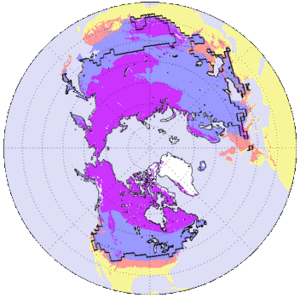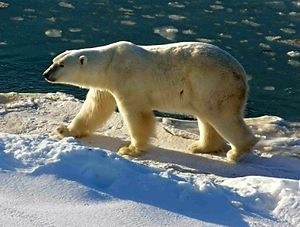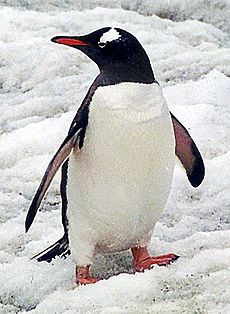Polar regions of Earth facts for kids
The polar regions are the coldest parts of Earth. They are found around the North Pole and the South Pole. These areas are also called the frigid zones. In the north, the Arctic Ocean is mostly covered by floating sea ice. In the south, the continent of Antarctica has a huge ice sheet.
Contents
What are the Polar Regions?
The Arctic is the area around the North Pole. People define it in different ways. It can be the region north of the Arctic Circle. This is an imaginary line at about 66.5 degrees North latitude. Sometimes, it's defined as the area north of 60 degrees North latitude. It can also be the land north of where trees stop growing.
The Antarctic is the area around the South Pole. It is usually defined as the region south of 60 degrees South latitude. It also includes the continent of Antarctica. The Antarctic Treaty from 1959 uses this definition.
The polar regions are very different from other parts of Earth. The tropics are warm areas near the equator. The middle latitudes are between the tropics and the polar regions.
Polar Climate
The polar regions get less strong sunlight than other parts of Earth. This is because the sun's energy hits the ground at a low angle. This spreads the light over a larger area. The sunlight also travels a longer way through Earth's atmosphere. This means more light is absorbed or reflected before it reaches the ground. This is why winters are colder in other parts of the world too.
Earth's tilt also greatly affects the polar climate. The polar regions are the farthest from the equator. So, they get the weakest sunlight. This makes them very cold all year. Even in summer, the sun's rays are not strong enough to warm them much. A lot of ice and snow also reflects the weak sunlight. This helps keep the polar regions very cold.
These regions have extremely cold temperatures. They also have a lot of ice, called glaciation, where there is enough snow. The amount of daylight changes a lot. In summer, there can be 24 hours of daylight, called the midnight sun. In mid-winter, there can be complete darkness, known as polar night.
The Arctic Region
Many people live in Earth's northern polar region. Several countries have land in the Arctic. These include the United States (Alaska), Canada, Denmark (Greenland), Norway, Finland, Sweden, Iceland, and Russia. People living in the Arctic often have more in common with each other than with people in other parts of their own countries. This makes the northern polar region rich in different cultures and communities.
Antarctica and the Southern Ocean
No humans live permanently in the southern polar region. McMurdo Station is the largest research station in Antarctica. The United States runs it. Other important stations include Palmer Station and Amundsen–Scott South Pole Station (United States). There are also Esperanza Base and Marambio Base (Argentina), Scott Base (New Zealand), and Vostok Station (Russia).
Even though no people live there, the southern polar region has a complex natural system. This is especially true along Antarctica's coasts. Nutrients rise from the deep ocean to the surface. This helps tiny sea creatures called krill to grow. Krill are a type of marine crustacean. Many animals, from penguins to blue whales, eat krill.
See also
 In Spanish: Regiones polares para niños
In Spanish: Regiones polares para niños




